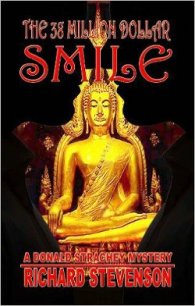Congo - Crichton Michael (книги регистрация онлайн бесплатно .TXT) 📗
“What can we do?” Elliot asked.
“I was hoping you’d have an answer for that,” Munro said. “You examined the bodies.”
Elliot stated his belief that they were confronted with a new species of primate. He summarized the anatomical findings, which supported his beliefs.
“That’s all well and good,” Munro said. “But I’m interested in how they act, not how they look. You said it yourself-gorillas are usually diurnal animals, and these are nocturnal. Gorillas are usually shy and avoid men, while these are aggressive and attack men fearlessly. Why?”
Elliot had to admit that he didn’t know.
“Considering our ammunition supplies, I think we’d better find out,” Munro said.
2. The Temple
THE LOGICAL PLACE TO BEGIN WAS THE TEMPLE, with its enormous, menacing gorilla statue. They returned that afternoon, and found behind the statue a succession of small cubicle-like rooms. Ross thought that priests who worshiped the cult of the gorilla lived here.
She had an elaborate explanation: “The gorillas in the surrounding jungle terrorized the people of Zinj, who offered sacrifices to appease the gorillas. The priests were a separate class, secluded from society. Look here, at the entrance to the line of cubicles, there is this little room. A guard stayed here to keep people away from the priests. It was a whole system of belief.”
Elliot was not convinced, and neither was Munro. “Even religion is practical,” Munro said. “It’s supposed to benefit you.’,
“People worship what they fear,” Ross said, “hoping to control it.’’
“But how could they control the gorillas?” Munro asked. “What could they do?”
When the answer finally came it was startling, for they had it all backward.
They moved past the cubicles to a series of long corridors, decorated with bas-reliefs. Using their infrared computer system, they were able to see the reliefs, which were scenes arranged in a careful order like a picture textbook.
The first scene showed a series of caged gorillas. A black man stood near the cages holding a stick in his hand.
The second picture showed an African standing with two gorillas, holding ropes around their necks.
A third showed an African instructing the gorillas in a courtyard. The gorillas were tethered to vertical poles, each with a ring at the top.
The final picture showed the gorillas attacking a line of straw dummies, which hung from an overhead stone support. They now knew the meaning of what they had found in the courtyard of the gymnasium, and the jail.
“My God,” Elliot said. “They trained them.”
Munro nodded. “Trained them as guards to watch over the mines. An animal elite, ruthless and incorruptible. Not a bad idea when you think about it.”
Ross looked at the building around her again, realizing it wasn’t a temple but a school. An objection occurred to her these pictures were hundreds of years old, the trainers long gone. Yet the gorillas were still here. “Who teaches them now?”
“They do,” Elliot said. “They teach each other.”
“Is that possible?”
“Perfectly possible. Conspecific teaching occurs among Primates.”
This had been a longstanding question among researchers. But Washoe, the first primate in history to learn sign language, taught ASL to her offspring. Language-skilled primates freely taught other animals in captivity; for that matter, they would teach people, signing slowly and repeatedly until the stupid uneducated human person got the point.
So it was possible for a primate tradition of language and behavior to be carried on for generations. “You mean,” Ross said, “that the people in this city have been gone for centuries, but the gorillas they trained are still here?”
“That’s the way it looks,” Elliot said.
“And they use stone tools?” she asked. “Stone paddles.”
“Yes,” Elliot said. The idea of tool use was not as farfetched as it first seemed. Chimpanzees were capable of elaborate tool use, of which the most striking example was “termite fishing.” Chimps would make a twig, carefully bending it to their specifications, and then spend hours over a termite mound, fishing with the stick to catch succulent grubs.
Human observers labeled this activity “primitive tool use” until they tried it themselves. It turned out that making a satisfactory twig and catching termites was not primitive at all; at least it proved to be beyond the ability of people who tried to duplicate it. Human fishermen quit, with a new respect for the chimpanzees, and a new observation-they now noticed that younger chimps spent days watching their elders make sticks and twirl them in the mound. Young chimps literally learned how to do it, and the learning process extended over a period of years.
This began to look suspiciously like culture; the apprenticeship of young Ben Franklin, printer, was not so different from the apprenticeship of young Chimpanzee, termite fisher. Both learned their skills over a period of years by observing their elders; both made mistakes on the way to ultimate success.
Yet manufactured stone tools implied a quantum jump beyond twigs and termites. The privileged position of stone tools as the special province of mankind might have remained sacrosanct were it not for a single iconoclastic researcher. In 1971, the British scientist R. V. S. Wright decided to teach an ape to make stone tools. His pupil was a five-year-old orangutan named Abang in the Bristol zoo. Wright presented Abang with a box containing food, bound with a rope; he showed Abang how to cut the rope with a flint chip to get the food. Abang got the point in an hour.
Wright then showed Abang how to make a stone chip by striking a pebble against a flint core. This was a more difficult lesson; over a period of weeks, Abang required a total of three hours to learn to grasp the flint core between his toes, strike a sharp chip, cut the rope, and get the food.
The point of the experiment was not that apes used stone tools, but that the ability to make stone tools was literally within their grasp. Wright’s experiment was one more reason to think that human beings were not as unique as they had previously imagined themselves to be.
“But why would Amy say they weren’t gorillas?”
“Because they’re not,” Elliot said. “These animals don’t look like gorillas and they don’t act like gorillas. They are physically and behaviorally different.” He went on to voice his suspicion that not only had these animals been trained, they had been bred-perhaps interbred with chimpanzees or, more strangely still, with men.
They thought he was joking. But the facts were disturbing. In 1960, the first blood protein studies quantified the kinship between man and ape. Biochemically man’s nearest relative was the chimpanzee, much closer than the gorilla. In 1964, chimpanzee kidneys were successfully transplanted into men; blood transfusions were also possible.
But the degree of similarity was not fully known until 1975, when biochemists compared the DNA of chimps and men. It was discovered that chimps differed from men by only 1 percent of their DNA strands. And almost no one wanted to acknowledge one consequence: with modern DNA hybridization techniques and embryonic implantation, ape-ape crosses were certain, and man-ape crosses were possible.
Of course, the fourteenth-century inhabitants of Zinj had no way to mate DNA strands. But Elliot pointed out that they had consistently underestimated the skills of the Zinj people, who at the very least had managed, five hundred years ago, to carry out sophisticated animal-training procedures only duplicated by Western scientists within the last ten years.
And as Elliot saw it, the animals the Zinjians had trained presented an awesome problem.
“We have to face the realities,” he said. “When Amy was given a human IQ test, she scored ninety-two. For all practical purposes, Amy is as smart as a human being, and in many ways she is smarter-more perceptive and sensitive. She can manipulate us at least as skillfully as we can manipulate her.


![[Magazine 1968-012] - The Million Monsters Affair - Davis Robert Hart (серия книг .txt) 📗](/uploads/posts/books/56864/56864.jpg)

